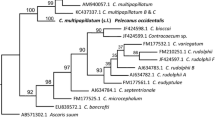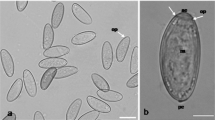Abstract
Various factors that influence in vitro pairing ofEchinostoma revolutum adults were studied. More worms paired in Locke's, Ringer's, and 0.85% NaCl solutions than in the defined medium NCTC 135. Also, more pairing occurred at 39 or 43°C than at 35°C. Echinostomes placed, 1, 3, or 5 cm apart in 5.5 cm diameter Petri dishes as well as those placed 2, 4, or 6 cm apart in 8.5 cm diameter Petri dishes paired; however, worms placed 8 cm apart in the latter dishes did not. Individuals maintained in Locke's solution at 20 or 39°C for 1 h after having been removed from the chicks paired less frequently than those used for experiments immediately after their removal from chicks. Worms showed more pairing in fresh Locke's solution than in this solution preconditioned by excretory-secretory products ofE. revolutum. Scanning electron microscopy revealed no differences between the tegument of fresh worms and of those maintained under experimental conditions for 2 h at 39°C.
Similar content being viewed by others
References
Bone LW, Shorey HH (1977) Disruption of sex pheromone communication in a nematode. Science 197:694–695
Eveland LK, Fried B, Cohen LM (1982)Schistosoma mansoni: Chemoattraction studies with adult worms in the presence and absence of barriers. Exper Parasitol 54:271–276
Fried B, Leiby DA (1982) Intraspecific and interspecific pairing ofHaematoloechus medioplexus (Trematoda) andEchinostoma revolutum (Trematoda) adultsin vitro, and observations onH. medioplexus lipophilic excretory-secretory products. Parasitology 84:375–380
Fried B, Roberts TM (1972) Pairing ofLeucochloridiomorpha constantiae (Mueller, 1935) (Trematoda)in vitro, in the chick and on the chorioallantois. J Parasitol 58:88–91
Fried B, Robinson GA (1981) Pairing and aggregation ofAmblosoma suwaense (Trematoda: Brachylaimidae) metacercariaein vitro and partial characterization of lipids involved in chemo-attraction. Parasitology 82:225–229
Fried B, Tancer RB, Fleming SJ (1980) In vitro pairing ofEchinostoma revolutum (Trematoda) metacercariae and adults, and characterization of worm products involved in chemoattraction. J Parasitol 66:1014–1018
Fried B, Weaver LJ (1969) Exposure of chicks to the metacercaria ofEchinostoma revolutum (Trematoda). Proc Helminthol Soc Wash 36:153–156
Fried B, Wilson DB (1981) Intraspecific and interspecific pairing ofEchinostoma revolutum (Trematoda) andZygocotyle lunata (Trematoda) adults in vitro. Proc Helminthol Soc Wash 48:243–245
Paul J (1975) Cell and Tissue Culture. 5th edn. Churchill Livingstone, Edinburgh
Sturkie P (1965) Avian Physiology. 2nd edn. Comstock Publishing Associates Ithaca
Tate ME, Clelland RC (1957) Nonparametric and Shortcut Statistics. Interstate Printers and Publishers, Danville
Wagner HM (1975) Principles of Operations Research. Prentice-Hall, Inc, Englewood Cliffs
Author information
Authors and Affiliations
Rights and permissions
About this article
Cite this article
Fried, B., Pallone, A. Further studies on in vitro pairing ofEchinostoma revolutum (Trematoda) adults. Z. Parasitenkd. 70, 297–302 (1984). https://doi.org/10.1007/BF00927815
Accepted:
Issue Date:
DOI: https://doi.org/10.1007/BF00927815




